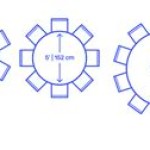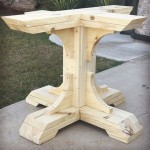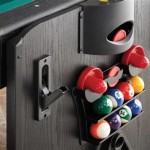Folding Ping Pong Table Dimensions: A Comprehensive Guide
Folding ping pong tables represent a popular solution for individuals and institutions seeking a recreational activity that can be easily stored when not in use. These tables offer a blend of convenience and functionality, making them suitable for various settings, including homes, schools, community centers, and office spaces. Understanding the dimensions of folding ping pong tables is crucial for ensuring adequate playing space, proper storage, and compatibility with existing infrastructure. This article provides a detailed exploration of folding ping pong table dimensions, covering regulation sizes, variations, storage considerations, and factors to consider when selecting the right table.
Regulation Dimensions of a Standard Ping Pong Table
The International Table Tennis Federation (ITTF) sets the standards for ping pong table dimensions to ensure fair and consistent gameplay across different tournaments and settings. A regulation-size ping pong table measures 9 feet (274 cm) in length, 5 feet (152.5 cm) in width, and 2.5 feet (76 cm) in height. These dimensions apply to both standard and folding ping pong tables designed for competitive or recreational use.
The playing surface, also known as the tabletop, is typically made of wood composite material, such as medium-density fiberboard (MDF), and coated with a smooth, matte finish to provide a consistent ball bounce. The tabletop is divided into two equal halves by a white centerline that runs parallel to the sides, used during doubles play to delineate service areas. A net, measuring 6 feet (183 cm) in length and 6 inches (15.25 cm) in height, is stretched across the middle of the table, dividing the two playing areas.
Folding ping pong tables adhere to these regulation dimensions when unfolded for play. The folding mechanism allows the table to be collapsed into a compact form for storage, but the playing surface remains consistent with the ITTF standards. This ensures that players can practice and compete on a folding table without compromising the integrity of the game.
Variations in Folding Ping Pong Table Dimensions
While regulation dimensions are standard for competitive play, variations exist in folding ping pong table dimensions to cater to different space constraints and user preferences. These variations primarily involve the thickness of the tabletop, the size of the legs and frame, and the folded dimensions of the table.
Tabletop Thickness: The thickness of the tabletop can vary depending on the quality and price of the table. Regulation-grade tables typically have a tabletop thickness of 1 inch (25 mm), which provides a consistent and reliable ball bounce. Lower-cost folding tables may have thinner tabletops, ranging from 1/2 inch (12 mm) to 3/4 inch (19 mm). While thinner tabletops may be more affordable and lighter, they may not offer the same level of performance as thicker tabletops.
Leg and Frame Dimensions: The size and design of the legs and frame can also vary among different folding ping pong tables. Some tables have larger, sturdier legs and frames for increased stability, while others have more compact designs to minimize storage space. The dimensions of the legs and frame can affect the overall weight and portability of the table.
Folded Dimensions: The folded dimensions of a folding ping pong table are a critical consideration for storage. Different folding mechanisms and designs can result in varying folded dimensions. Some tables fold in half, with the two halves stacking vertically, while others fold into a more compact form with the legs retracting or folding inwards. Understanding the folded dimensions is essential for determining whether the table will fit in the designated storage area.
For instance, a typical folding table might have folded dimensions of approximately 6 feet (183 cm) in height, 5 feet (152.5 cm) in width, and 2 feet (61 cm) in depth, depending on the specific model and design. These dimensions should be carefully considered to ensure that the table can be stored in a garage, closet, or other storage space without obstructing access or causing inconvenience.
Storage Considerations for Folding Ping Pong Tables
The primary advantage of folding ping pong tables is their ability to be stored compactly when not in use. However, effective storage requires careful consideration of the table's folded dimensions, the available storage space, and any potential environmental factors that could affect the table's condition.
Measuring Storage Space: Before purchasing a folding ping pong table, it is essential to measure the available storage space to ensure that the table will fit comfortably. Consider the height, width, and depth of the storage area, as well as any obstructions, such as pipes, shelves, or other stored items. Allow for a small amount of extra space to facilitate easy maneuvering of the table into and out of the storage area.
Storage Orientation: Most folding ping pong tables are designed to be stored vertically, with the two halves of the tabletop stacked one above the other. This orientation minimizes the footprint of the table and allows it to be stored in a relatively narrow space. However, some tables can also be stored horizontally, with the tabletop lying flat on the floor or on a raised platform. Horizontal storage may be preferable in certain situations, such as when there is limited vertical space or when the table needs to be protected from dust and debris.
Environmental Factors: The storage environment can significantly impact the condition of a folding ping pong table. Exposure to extreme temperatures, humidity, or direct sunlight can cause warping, cracking, or fading of the tabletop. It is best to store the table in a cool, dry, and well-ventilated area, away from direct sunlight. A protective cover can also be used to shield the table from dust, dirt, and moisture.
Mobility and Handling: Many folding ping pong tables are equipped with wheels or casters to facilitate easy transportation and maneuvering. These wheels allow the table to be rolled from one location to another without the need for lifting or carrying. When storing the table, ensure that the wheels are locked or secured to prevent accidental movement. Use caution when moving the table, especially on uneven surfaces or through narrow doorways, to avoid damage to the table or surrounding objects.
Long-Term Storage: For long-term storage, it is advisable to take additional precautions to protect the folding ping pong table. Clean the tabletop thoroughly before storing it to remove any dirt or debris. Apply a protective coating, such as furniture polish or wax, to help prevent moisture absorption and maintain the finish. Consider disassembling the legs and frame to further reduce the storage space required. Store all hardware and accessories, such as the net and paddles, in a separate container to prevent them from getting lost or damaged.
Factors to Consider When Selecting a Folding Ping Pong Table
Choosing the right folding ping pong table involves considering several factors, including playing space, storage capacity, budget, and intended use. Evaluating these factors will help ensure that the selected table meets the specific needs and requirements of the user.
Playing Space: The amount of available playing space is a critical consideration when selecting a folding ping pong table. While the table itself adheres to regulation dimensions when unfolded, adequate space is needed around the table for players to move freely and comfortably. The ITTF recommends a minimum playing area of 16 feet (4.88 meters) in length and 8 feet (2.44 meters) in width. However, a larger playing area may be desirable for more competitive play or for accommodating multiple players.
Storage Capacity: The available storage capacity is another essential factor to consider. Measure the storage space carefully and compare it to the folded dimensions of different folding ping pong tables. Choose a table that can be easily stored in the designated area without obstructing access or causing inconvenience. Consider the ease of folding and unfolding the table, as well as the weight and portability of the table when making a selection.
Budget: Folding ping pong tables are available in a wide range of prices, depending on the quality of materials, construction, and features. Establish a budget before beginning the search and compare the features and benefits of different tables within that price range. Consider the long-term value of the table and whether it is worth investing in a higher-quality table that will provide better performance and durability.
Intended Use: The intended use of the folding ping pong table will also influence the selection process. For casual recreational play, a lower-cost table with a thinner tabletop may be sufficient. However, for more competitive play or for use in a club or school setting, a regulation-grade table with a thicker tabletop and sturdier construction is recommended. Consider any specific features or accessories that may be required, such as adjustable levelers, safety locks, or a built-in storage compartment for paddles and balls.
Tabletop Material and Thickness: The tabletop material and thickness significantly impact the table's playability and durability. MDF (medium-density fiberboard) is a common material for ping pong tabletops due to its smooth surface and consistent bounce. Thicker tabletops, such as 1 inch (25 mm), provide a better bounce and are less prone to warping. Consider the tabletop material and thickness when evaluating different folding ping pong tables.
Frame and Leg Construction: The frame and leg construction determine the table's stability and durability. Look for a table with a sturdy steel frame and robust legs that can withstand regular use. Adjustable levelers on the legs can help ensure that the table is level, even on uneven surfaces. Consider the quality of the frame and leg construction when making a selection.
Safety Features: Safety features, such as locking mechanisms and corner protectors, can help prevent accidents and injuries. Look for a table with safety locks that prevent the table from collapsing during play. Corner protectors can help cushion impacts and prevent injuries from sharp edges. Consider the safety features when evaluating different folding ping pong tables, especially if the table will be used by children or in a public setting.
By carefully considering these factors, individuals and institutions can select a folding ping pong table that meets their specific needs and requirements, providing years of enjoyment and recreational activity.

Indoor Outdoor Foldable Mobile Table Tennis Cuu43327805 The Home Depot

Espn Official Size 2 Piece 15mm Indoor Quick Match Table Tennis Blue Com

Table Tennis Measurements Size And Dimensions Cornilleau

Tidoin 6 Ft Mid Size Table Tennis Foldable Portable Ping Pong Set With Net 2 Paddles And 3 Balls Aok Ydw1 519 The Home Depot

Ping Pong Table Dimensions Diy Outdoor

Table Tennis Midsize Foldable Portable Ping Pong Set With Net And 2 Paddles For Indoor Outdoor Game Com

Siavonce 6 Ft Mid Size Foldable Portable Ping Pong Table Set For Indoor Outdoor With Net 2 Tennis Paddles And 3 Balls Dj Zx W140860519 The Home Depot

Md Sports Official Size Table Tennis Black Yellow

To Choose The Right Table Tennis Size For You Stiga Sports

Lancaster 4 Piece Official Tournament Size 108 X 60 30 Inches Indoor








